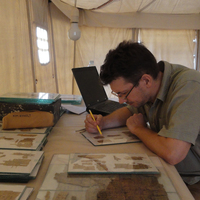
Kim Ryholt
University of Copenhagen, Department of Cross-Cultural and Regional Studies (Egyptology Section), Professor of Egyptology
Address: Department of Cross-Cultural and Regional Studies
University of Copenhagen
Karen Blixens Plads 8
DK-2300 Copenhagen S
Denmark
University of Copenhagen
Karen Blixens Plads 8
DK-2300 Copenhagen S
Denmark
less
Related Authors
Charles Jones
The Pennsylvania State University
Aaron A Burke
University of California, Los Angeles
Maria Nilsson
Lund University
Jana Mynářová
Charles University, Prague
Ellen Morris
Barnard College
Ian Rutherford
University of Reading
Ivan Ladynin
Moscow State University
Andrea Squitieri
Ludwig-Maximilians-Universität München
Irene Forstner-Müller
Austrian Academy of Sciences
Alexander Fantalkin
Tel Aviv University
InterestsView All (27)










Uploads
Papers by Kim Ryholt
A hitherto unknown composition is highlighted in the red and black inks preserved on ancient Egyptian papyri from the Roman period (circa 100 to 200 CE). Synchrotron-based macro–X-ray fluorescence (XRF) mapping brings to light the presence of iron (Fe) and lead (Pb) compounds in the majority of the red inks inscribed on 12 papyrus fragments from the Tebtunis temple library. The iron-based compounds in the inks can be assigned to ocher, notably due to the colocalization of Fe with aluminum, and the detection of hematite (Fe2O3) by micro–X-ray diffraction. Using the same techniques together with micro-Fourier transform infrared spectroscopy, Pb is shown to be associated with fatty acid phosphate, sulfate, chloride, and carboxylate ions. Moreover, micro-XRF maps reveal a peculiar distribution and colocalization of Pb, phosphorus (P), and sulfur (S), which are present at the micrometric scale resembling diffused “coffee rings” surrounding the ocher particles imbedded in the red letters, and at the submicrometric scale concentrated in the papyrus cell walls. A similar Pb, P, and S composition was found in three black inks, suggesting that the same lead components were employed in the manufacture of carbon-based inks. Bearing in mind that pigments such as red lead (Pb3O4) and lead white (hydrocerussite [Pb3(CO3)2(OH)2] and/or cerussite [PbCO3]) were not detected, the results presented here suggest that the lead compound in the ink was used as a drier rather than as a pigment. Accordingly, the study calls for a reassessment of the composition of lead-based components in ancient Mediterranean pigments.
10.1. Introduction
10.2. Temple libraries
10.2.1. The Tebtunis Temple Library (First-Second Century CE)
10.2.2. The "Elephantine Temple Library" (Seventh-Third Century BCE)
10.3. Private Libraries
10.3.1. The Brooklyn Library (Seventh-Sixth Century BCE)
10.3.2. The Archive of Ptolemaios and Apollonios (Second Century BCE)
10.4. Tomb libraries
10.4.1. The Sminis Tomb Library (Late Fourth Century BCE)
10.4.2. Akhmim Tomb Libraries (First Century BCE)
10.5. Discarded Literary Texts and Libraries
10.5.1. Papyri from the Rubbish Dumps of Saqqara
10.5.2. Waste Paper Library from Tanis
10.5.3. Cartonnage Library from Abusir el-Melek (First Century BCE)
10.6. Monumental Temples Libraries and the House of the Book
10.6.1. The Temple of Horus of Edfu
10.6.2. The Temple of Isis at Philae
10.6.3. The Temples of Month at Medamud and Nekhbet at Elkab
10.6.4. The Temple of Month at Tod
10.6.5. Book Catalogues from Temples
10.7. The Narmuthis School
10.8. The House of Life and the Cult of Osiris
10.9. Papyrus Storage
10.10. Leather Master Copies
10.11. Abduction of Egyptian Libraries
10.11.1. The Temple Library of Tell Tukh el-Qaramus?
10.12. Acquisition of Literature
10.13. Conclusions
1.1. The Library in Alexandria
1.2. A Comparative Approach to Libraries in Egypt and Western Asia
1.3. Defining Libraries
1.4. Advent of Writing and First Libraries
1.5. Materiality and Manuscript
1.6. Patterns of Preservation
1.7. The Deposition of Manuscripts
1.8. Excavations and Collections
1.9. Types of Collections
1.10. Access and Acquisition
1.11. Language and Script
1.12. Literacy and Reading
1.13. The Architecture of Libraries
1.14. Storage and Maintenance
1.15. Content and Volume
1.16. Closing Remarks
hand, which is perhaps best known to colleagues from the two copies of Petechons
and Sarpot in Vienna (table, nos 1 and 2). The purpose of the present paper is to bring
attention to these papyri as a group and to discuss their possible provenance and
social context. It will be argued that the bulk of the papyri derive from discoveries at
two different sites; the larger in the 1880s, possibly in the area of Medinet el-Fayum,
and the second in the early 1930s at Tebtunis.
that the phenomenon was not confined to larger temples such as those of Tebtunis and Soknopaiou Nesos. They may further be seen to conform closely in structure and nature with the self-dedications from Tebtunis, although there is some slight formulaic variation, and they also fall within the same date-range. There is still no indication that the phenomenon of self-dedication, as we know it from these texts, was practiced outside the second century BC. With reference to the two self-dedications and other material, the present paper will further argue that the main deities of the temple at Euhemeria were not Suchos and Isis, as hitherto assumed, but local form of Isis called Isis-Nephersais, 'Isis with the beautiful fate', accompanied by her son and her husband, Harpsenêsis and Osiris-Onnôphris.
The present study presents a comprehensive, statistical seriation of seal typology based on a database comprising more than one thousand items. It is argued that it is possible to identify a consistent typological development, according to which the seals in question may be arranged in a chronological sequence, and that the distinct typological features of the seals reflect a centralized production, in effect the existence of a royal workshop. Proceeding from a seriation of seals inscribed for kings, it is possible also to assign relative dates to a large number of seals inscribed for members of the royal family and high officials, and to place these individuals in a more specific historical context. The seriation of these seals and their dating, in turn, allow for a number of observations concerning the political history of the 14th and 15th Dynasties.
certain formal features of the texts, and the palaeography of the scribes
involved.
by the same mission, are both significant despite their unimpressive sizes, partly because texts of their nature are something that one would mainly expect to find within priestly communities at this late date, where few individuals are likely to have mastered hieratic and literary demotic elsewhere, and partly because both of them have a recorded archaeological context that included other literary texts in Greek. It is also worth noting that, while two houses contained Egyptian literature, Greek literature was found in at least 39 houses at Karanis. These houses mostly date to the second and third centuries AD.
For the first time it is shown that carbon black inks on ancient Egyptian papyri from different time periods and geographical regions contain copper. The inks have been investigated using synchrotron-based micro X-ray fluorescence (XRF) and micro X-ray absorption near-edge structure spectroscopy (XANES) at the European Synchrotron Radiation Facility (ESRF). The composition of the copper-containing carbon inks showed no significant differences that could be related to time periods or the geographical locations. This renders it probable that the same technology for ink production was used throughout Egypt for a period spanning at least 300 years. It is argued that the black pigment material (soot) for these inks was obtained as by-products of technical metallurgy. The copper (Cu) can be correlated with the following three main components: cuprite (Cu 2 O), azurite (Cu 3 [CO 3 ] 2 [OH] 2) and malachite (Cu 2 CO 3 [OH] 2).
A hitherto unknown composition is highlighted in the red and black inks preserved on ancient Egyptian papyri from the Roman period (circa 100 to 200 CE). Synchrotron-based macro–X-ray fluorescence (XRF) mapping brings to light the presence of iron (Fe) and lead (Pb) compounds in the majority of the red inks inscribed on 12 papyrus fragments from the Tebtunis temple library. The iron-based compounds in the inks can be assigned to ocher, notably due to the colocalization of Fe with aluminum, and the detection of hematite (Fe2O3) by micro–X-ray diffraction. Using the same techniques together with micro-Fourier transform infrared spectroscopy, Pb is shown to be associated with fatty acid phosphate, sulfate, chloride, and carboxylate ions. Moreover, micro-XRF maps reveal a peculiar distribution and colocalization of Pb, phosphorus (P), and sulfur (S), which are present at the micrometric scale resembling diffused “coffee rings” surrounding the ocher particles imbedded in the red letters, and at the submicrometric scale concentrated in the papyrus cell walls. A similar Pb, P, and S composition was found in three black inks, suggesting that the same lead components were employed in the manufacture of carbon-based inks. Bearing in mind that pigments such as red lead (Pb3O4) and lead white (hydrocerussite [Pb3(CO3)2(OH)2] and/or cerussite [PbCO3]) were not detected, the results presented here suggest that the lead compound in the ink was used as a drier rather than as a pigment. Accordingly, the study calls for a reassessment of the composition of lead-based components in ancient Mediterranean pigments.
10.1. Introduction
10.2. Temple libraries
10.2.1. The Tebtunis Temple Library (First-Second Century CE)
10.2.2. The "Elephantine Temple Library" (Seventh-Third Century BCE)
10.3. Private Libraries
10.3.1. The Brooklyn Library (Seventh-Sixth Century BCE)
10.3.2. The Archive of Ptolemaios and Apollonios (Second Century BCE)
10.4. Tomb libraries
10.4.1. The Sminis Tomb Library (Late Fourth Century BCE)
10.4.2. Akhmim Tomb Libraries (First Century BCE)
10.5. Discarded Literary Texts and Libraries
10.5.1. Papyri from the Rubbish Dumps of Saqqara
10.5.2. Waste Paper Library from Tanis
10.5.3. Cartonnage Library from Abusir el-Melek (First Century BCE)
10.6. Monumental Temples Libraries and the House of the Book
10.6.1. The Temple of Horus of Edfu
10.6.2. The Temple of Isis at Philae
10.6.3. The Temples of Month at Medamud and Nekhbet at Elkab
10.6.4. The Temple of Month at Tod
10.6.5. Book Catalogues from Temples
10.7. The Narmuthis School
10.8. The House of Life and the Cult of Osiris
10.9. Papyrus Storage
10.10. Leather Master Copies
10.11. Abduction of Egyptian Libraries
10.11.1. The Temple Library of Tell Tukh el-Qaramus?
10.12. Acquisition of Literature
10.13. Conclusions
1.1. The Library in Alexandria
1.2. A Comparative Approach to Libraries in Egypt and Western Asia
1.3. Defining Libraries
1.4. Advent of Writing and First Libraries
1.5. Materiality and Manuscript
1.6. Patterns of Preservation
1.7. The Deposition of Manuscripts
1.8. Excavations and Collections
1.9. Types of Collections
1.10. Access and Acquisition
1.11. Language and Script
1.12. Literacy and Reading
1.13. The Architecture of Libraries
1.14. Storage and Maintenance
1.15. Content and Volume
1.16. Closing Remarks
hand, which is perhaps best known to colleagues from the two copies of Petechons
and Sarpot in Vienna (table, nos 1 and 2). The purpose of the present paper is to bring
attention to these papyri as a group and to discuss their possible provenance and
social context. It will be argued that the bulk of the papyri derive from discoveries at
two different sites; the larger in the 1880s, possibly in the area of Medinet el-Fayum,
and the second in the early 1930s at Tebtunis.
that the phenomenon was not confined to larger temples such as those of Tebtunis and Soknopaiou Nesos. They may further be seen to conform closely in structure and nature with the self-dedications from Tebtunis, although there is some slight formulaic variation, and they also fall within the same date-range. There is still no indication that the phenomenon of self-dedication, as we know it from these texts, was practiced outside the second century BC. With reference to the two self-dedications and other material, the present paper will further argue that the main deities of the temple at Euhemeria were not Suchos and Isis, as hitherto assumed, but local form of Isis called Isis-Nephersais, 'Isis with the beautiful fate', accompanied by her son and her husband, Harpsenêsis and Osiris-Onnôphris.
The present study presents a comprehensive, statistical seriation of seal typology based on a database comprising more than one thousand items. It is argued that it is possible to identify a consistent typological development, according to which the seals in question may be arranged in a chronological sequence, and that the distinct typological features of the seals reflect a centralized production, in effect the existence of a royal workshop. Proceeding from a seriation of seals inscribed for kings, it is possible also to assign relative dates to a large number of seals inscribed for members of the royal family and high officials, and to place these individuals in a more specific historical context. The seriation of these seals and their dating, in turn, allow for a number of observations concerning the political history of the 14th and 15th Dynasties.
certain formal features of the texts, and the palaeography of the scribes
involved.
by the same mission, are both significant despite their unimpressive sizes, partly because texts of their nature are something that one would mainly expect to find within priestly communities at this late date, where few individuals are likely to have mastered hieratic and literary demotic elsewhere, and partly because both of them have a recorded archaeological context that included other literary texts in Greek. It is also worth noting that, while two houses contained Egyptian literature, Greek literature was found in at least 39 houses at Karanis. These houses mostly date to the second and third centuries AD.
For the first time it is shown that carbon black inks on ancient Egyptian papyri from different time periods and geographical regions contain copper. The inks have been investigated using synchrotron-based micro X-ray fluorescence (XRF) and micro X-ray absorption near-edge structure spectroscopy (XANES) at the European Synchrotron Radiation Facility (ESRF). The composition of the copper-containing carbon inks showed no significant differences that could be related to time periods or the geographical locations. This renders it probable that the same technology for ink production was used throughout Egypt for a period spanning at least 300 years. It is argued that the black pigment material (soot) for these inks was obtained as by-products of technical metallurgy. The copper (Cu) can be correlated with the following three main components: cuprite (Cu 2 O), azurite (Cu 3 [CO 3 ] 2 [OH] 2) and malachite (Cu 2 CO 3 [OH] 2).
Yet, although the scale of the collection in Alexandria seems to have been unprecedented, the notion of creating central repositories of knowledge, while perhaps new to Greek tradition, was age-old in the Near East where the building was erected. Here the existence of libraries can be traced back another two millennia, from the twenty-seventh century BCE, and so the creation of the Library in Alexandria was not so much the beginning of an intellectual adventure as the impressive culmination of a very long tradition.
This volume presents the first comprehensive study of these ancient libraries across the Near East and traces their institutional and scholarly roots back to the early cities and states and the advent of writing itself. Leading specialists in the intellectual history of each individual period and region covered in the volume present and discuss the enormous textual and archaeological material available on the early collections, offering a uniquely readable account intended for a broad audience of the libraries in Egypt and Western Asia as centres of knowledge prior to the famous Library of Alexandria.
TOC
1. Libraries before Alexandria, Kim Ryholt and Gojko Barjamovic
2. The Rise of Libraries in the Near East, c. 2600-2300 BCE, Kamran Vincent Zand
3. Libraries in Ancient Egypt, c. 2600-1600 BCE, R. B. Parkinson
4. Archives and Libraries in the Old Babylonian Period, c. 1900-1600 BCE, Paul Delnero
5. The Tablet Collections of the Hittite Empire, c. 1450-1100 BCE, Paola Dardano
6. Libraries in Ancient Syria and the Levant in the Late Bronze Age, c. 1450-1100 BCE, Matthew Rutz
7. Libraries in Ancient Egypt, c. 1600-800 BCE, Fredrik Hagen
8. Scholarly Tablet Collections in First-Millennium Assyria and Babylonia, c. 700-200 BCE, Eleanor Robson and Kathryn Stevens
9. Assurbanipal's Library: An Overview, Irving Finkel
10. Libraries from Late Period and Greco-Roman Egypt, c. 800 BCE-250 CE, Kim Ryholt
The book presents the first in-depth analysis of this market during its “golden age” in Egypt in the late 19th and early 20th Century. It is primarily based on the archival material of the Danish Egyptologist H. O. Lange (1863-1943) who, during two prolonged stays in Egypt (1899/1900 and 1929/1930), bought objects on behalf of Danish museums. The travel diaries, and the accompanying photographs, are complemented by a wide range of other sources, including contemporary travel guides and various travel memoirs, which together paint an extraordinarily detailed picture of the extensive antiquities trade.
The book looks at the laws governing trade and export, both in theory and practice, and the changes over time. The practicalities of the trade are described: its seasons, the networks of supply, the various methods available for acquiring antiquities, and the subsequent routes of transmission of objects, as well as the different types of dealers operating in Egypt. The geographical distribution of dealers is mapped, and the role of the Egyptian state as a dealer is investigated, both through official sale rooms, and as a seller and exporter of more or less complete tomb-chapels.
The final part of the book contains a list, with short biographies, of over 250 dealers active in Egypt from the 1880s until the abolishment of the trade in 1983. Most of them are described here in detail for the first time.
The book will be of interest to archaeologists, Egyptologists, papyrologists, museum curators, and historians of science, and is a useful starting point for anyone wishing to understand how the great Western collections of Egyptian antiquities were formed.
From early on, texts from the written traditions of ancient Mesopotamia and Egypt were accumulated, codified, and to some extent canonized, as various collections developed mainly in the environment of the temple and the palace. These written traditions represent sets of formal and informal cultures that all speak in their own ways of canonicity, normativity, and other forms of cultural expertise. Some forms of literature were used not only in scholarly contexts, but also in political ones, and they served purposes of identity formation.
This volume publishes the papers from two conferences held at the Center for Canon and Identity Formation at the University of Copenhagen in 2010 that address interrelations between various forms of ‘canon’ and identity formation in different time periods, genres, regions, and contexts, as well as the application of contemporary conceptions of ‘canon’ to ancient texts.
The Tebtunis temple library is the only ancient Egyptian temple library of which substantial remains are preserved, and the immense material - estimated at several hundred manuscripts - makes it by far the richest, single source of Egyptian literary texts.
The present volume is introduced by a survey of the hieratic and hieroglyphic manuscripts from the temple library. The main genres are discussed and conclusions are drawn concerning the sort of compositions transmitted in hieratic as well as the cultural values which lie behind the choices.
The survey is followed by full editions of a series of religious texts: an Osiris liturgy (with red dots and crosses which seem to represent a kind of rudimentary musical notation), the Ritual of Bringing Sokar out of the Shetit (previously known only from monumental hieroglyphic versions from temples and manuscripts for funerary use), the Votive Cubit (otherwise known essentially from fragments of the original stone cubits), the Nine-Headed Bes (a parallel to the famous illustrated Brooklyn papyrus but with a fuller description of how the practitioner should proceed), and the Ritual of Opening the Mouth (one version written for Sobek, lord of Tebtunis, the others for Sokar-Osiris). The volume further includes a slip of papyrus with four book-titles, a papyrus with a colored drawing of an offering scene, and a decorated band for tying up a papyrus roll."
Contributions by K.T. Zauzich, H.S. Smith, B. Porten, U. Kaplony-Heckel, R.K. Ritner, S. Allam, M. Chauveau, D. Devauchelle et al. "
Edited by P. J. Frandsen and K. Ryholt. Contributions by J.F. Quack, K. Ryholt, M. Smith, W.J. Tait and K.-Th. Zauzich."
The dissertation is a new attempt to establish a chronology for the Second Intermediate Period and define the different kingdoms, their territories and political relations. The study consists of four main chapters, three appendixes, a catalogue of sources, bibliography and indices.
Included is a catalogue of all the historical sources, about 1500, known to certify the names of the Egyptian kings of the Second Intermediate Period. Each source is described in terms of type, origin and present location, followed by bibliographical references.""
of fundamental importance within the Human Sciences. The
CoNeXT project Ancient Ink as Technology focusses on ancient
manuscripts. It addresses both a decisive chapter in the history
of science and also one of the central challenges facing
the historian: the fact that the majority of ancient manuscripts
lack a recorded archaeological context. Information about the
socio-historical context is naturally crucial, whether dealing with
ancient literature, diplomatic correspondences, administrative
documents, or family archives. X-ray analysis delivers chemical
and structural signatures, which reflect the physical properties
of manuscripts. It is our expectation that these “fingerprints”
will enable a mapping of characteristic traits of ink and
papyrus along both a chronological and geographical axis.